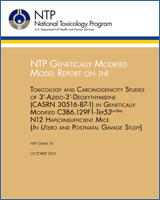This is a work of the US government and distributed under the terms of the Public Domain
NCBI Bookshelf. A service of the National Library of Medicine, National Institutes of Health.
Leakey JEA, Allaben WT, Dunnick JK, et al. NTP Genetically Modified Model Report on the Toxicology and Carcinogenicity Studies of 3’-Azido-3’-Deoxythymidine (CASRN 30516-87-1) in Genetically Modified C3B6.129F1-Trp53tm1Brd N12 Haploinsufficient Mice (In Utero and Postnatal Gavage Study): NTP GMM 14 [Internet]. Research Triangle Park (NC): National Toxicology Program; 2013 Oct.

NTP Genetically Modified Model Report on the Toxicology and Carcinogenicity Studies of 3’-Azido-3’-Deoxythymidine (CASRN 30516-87-1) in Genetically Modified C3B6.129F1-Trp53tm1Brd N12 Haploinsufficient Mice (In Utero and Postnatal Gavage Study): NTP GMM 14 [Internet].
Show detailsOn February 9, 2012, the draft Report on the studies of 3′-azido-3′-deoxythymidine received public review by the National Toxicology Program’s Board of Scientific Counselors’ Technical Reports Peer Review Panel. The review meeting was held at the National Institute of Environmental Health Sciences, Research Triangle Park, NC.
Dr. J.E.A. Leakey, FDA, reviewed information on the toxicity and carcinogenicity of AZT in rodents and humans, including absorption, distribution, metabolism and excretion issues and mechanisms of AZT-induced toxicity in eukaryotic cells. He presented information regarding AZT human toxicity, noting that long-term consequences of perinatal exposure to AZT are unknown. He provided background information regarding the development of the C3B6.129F1-Trp53tm1Brd N12 haploinsufficient mouse model, which is designed to develop tumors at an increased rate and thus shorten the duration of carcinogenicity studies.
The present study is the first study to use the model with perinatal exposure. Dr. Leakey reviewed the experimental design for the main study and stop-study, dosing AZT alone once per day from gestational day 12 to 9 months of age. He noted that the model was found to be sensitive enough to detect carcinogenesis, with a treatment-related tumor profile similar to that seen in the B6C3F1 mouse, mainly liver tumors and lymphomas. There was no evidence of clustering of lesions within litters.
The proposed conclusions for GMM 14 were clear evidence of carcinogenic activity of AZT in male heterozygous F1 p53+/− mice and equivocal evidence of carcinogenic activity of AZT in female heterozygous F1 p53+/− mice.
Dr. Elwell, the first primary reviewer, felt the studies were well designed, and he had no scientific criticisms. He felt that it would be useful to have some discussion in the report of the differences, if any, between the perinatal exposure and the exposure for the full 45 weeks. He asked if the occurrence of lymphoma in the stop-study should also be mentioned in “other findings.” He suggested that “other findings” that were dismissed or not brought forward to the summary or conclusions should be clarified in the discussion section. Based on the comment in the report on group size and statistical significance, he asked if the sample size should have been increased in the stop-study to improve the statistical ability of the study to discern small increases in tumor incidences. He said that there was indication of vagina examination only in the 30-week study tables, and asked whether that had also been examined in the 45-week study.
Dr. Soper, the second primary reviewer, agreed that the studies were well designed and well executed and agreed with the proposed conclusions.
Dr. Olivero, the third primary reviewer, expressed concern about the limited historical control database.
Dr. Leakey replied that when this study was written and evaluated, it was the only one of its kind, and thus the historical controls consisted of only 103 animals from the two companion studies and one other. He said that nonetheless, they were confident in the tumor diagnoses. He felt that the low tumor incidence was driven by haploinsufficiency rather than the actual dosing vehicle. He added that as the study series progresses, the historical control database would be built up. Regarding the stop-study, he noted that body weight within the latter stage of dosing does affect liver tumor incidence. He said that he would add some discussion of the “other findings” such as bone and brain tumors to offer more explanation as to why certain neoplasms were in the conclusions while others were not.
Dr. Olivero asked about the increase in hemoglobin. Dr. Leakey said that while it was statistically significant, it was not outside the physiological range. He said the investigators were expecting to see more anemia, as seen in industry studies where dosing was twice per day.
Dr. Mirsalis inquired about the appearance of the malignant lymphomas compared to those seen in B6C3F1 mice. Study Pathologist Dr. G.R. Olson, Toxicologic Pathology Associates, replied that the lymphomas looked much like those normally seen. However, in the second study, there were several undifferentiated tumors that needed to be further characterized. Dr. Elwell asked how the fatal malignant lymphomas compare to those in B6C3F1 mice at 45 weeks. Dr. Olson said they were the same as those seen in normal chronic studies.
Drs. Anderson and Olivero mentioned similar studies in CD1 mice, which had yielded very different results. Dr. Leakey said he would include their discussion in the report.
Dr. Elwell moved that the conclusions be accepted as written, and Dr. Mirsalis seconded the motion. The panel unanimously recommended acceptance of the conclusions as written.
- SUMMARY OF PEER REVIEW PANEL COMMENTS - NTP Genetically Modified Model Report on...SUMMARY OF PEER REVIEW PANEL COMMENTS - NTP Genetically Modified Model Report on the Toxicology and Carcinogenicity Studies of 3’-Azido-3’-Deoxythymidine (CASRN 30516-87-1) in Genetically Modified C3B6.129F1-Trp53tm1Brd N12 Haploinsufficient Mice (In Utero and Postnatal Gavage Study)
- DEAD-box ATP-dependent RNA helicase 38 [Solanum lycopersicum]DEAD-box ATP-dependent RNA helicase 38 [Solanum lycopersicum]gi|460408311|ref|XP_004249589.1|Protein
Your browsing activity is empty.
Activity recording is turned off.
See more...